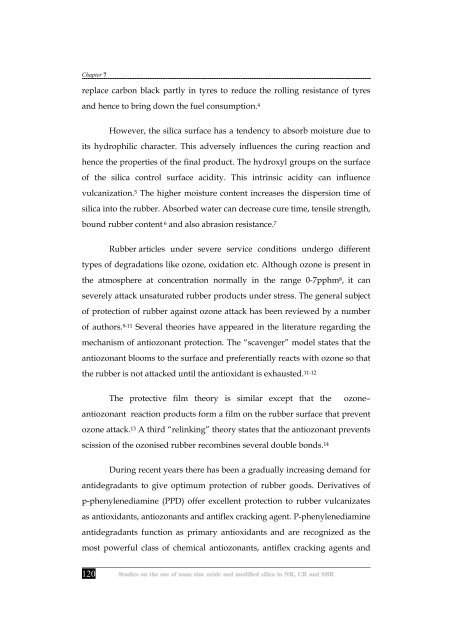Studies on the use of nano zinc oxide and modified silica in NR, CR ...
Studies on the use of nano zinc oxide and modified silica in NR, CR ...
Studies on the use of nano zinc oxide and modified silica in NR, CR ...
You also want an ePaper? Increase the reach of your titles
YUMPU automatically turns print PDFs into web optimized ePapers that Google loves.
Chapter 7<br />
replace carb<strong>on</strong> black partly <strong>in</strong> tyres to reduce <strong>the</strong> roll<strong>in</strong>g resistance <strong>of</strong> tyres<br />
<strong>and</strong> hence to br<strong>in</strong>g down <strong>the</strong> fuel c<strong>on</strong>sumpti<strong>on</strong>. 4<br />
120<br />
However, <strong>the</strong> <strong>silica</strong> surface has a tendency to absorb moisture due to<br />
its hydrophilic character. This adversely <strong>in</strong>fluences <strong>the</strong> cur<strong>in</strong>g reacti<strong>on</strong> <strong>and</strong><br />
hence <strong>the</strong> properties <strong>of</strong> <strong>the</strong> f<strong>in</strong>al product. The hydroxyl groups <strong>on</strong> <strong>the</strong> surface<br />
<strong>of</strong> <strong>the</strong> <strong>silica</strong> c<strong>on</strong>trol surface acidity. This <strong>in</strong>tr<strong>in</strong>sic acidity can <strong>in</strong>fluence<br />
vulcanizati<strong>on</strong>. 5 The higher moisture c<strong>on</strong>tent <strong>in</strong>creases <strong>the</strong> dispersi<strong>on</strong> time <strong>of</strong><br />
<strong>silica</strong> <strong>in</strong>to <strong>the</strong> rubber. Absorbed water can decrease cure time, tensile strength,<br />
bound rubber c<strong>on</strong>tent 6 <strong>and</strong> also abrasi<strong>on</strong> resistance. 7<br />
Rubber articles under severe service c<strong>on</strong>diti<strong>on</strong>s undergo different<br />
types <strong>of</strong> degradati<strong>on</strong>s like oz<strong>on</strong>e, oxidati<strong>on</strong> etc. Although oz<strong>on</strong>e is present <strong>in</strong><br />
<strong>the</strong> atmosphere at c<strong>on</strong>centrati<strong>on</strong> normally <strong>in</strong> <strong>the</strong> range 0-7pphm 8, it can<br />
severely attack unsaturated rubber products under stress. The general subject<br />
<strong>of</strong> protecti<strong>on</strong> <strong>of</strong> rubber aga<strong>in</strong>st oz<strong>on</strong>e attack has been reviewed by a number<br />
<strong>of</strong> authors. 9-11 Several <strong>the</strong>ories have appeared <strong>in</strong> <strong>the</strong> literature regard<strong>in</strong>g <strong>the</strong><br />
mechanism <strong>of</strong> antioz<strong>on</strong>ant protecti<strong>on</strong>. The “scavenger” model states that <strong>the</strong><br />
antioz<strong>on</strong>ant blooms to <strong>the</strong> surface <strong>and</strong> preferentially reacts with oz<strong>on</strong>e so that<br />
<strong>the</strong> rubber is not attacked until <strong>the</strong> antioxidant is exhausted. 11-12<br />
The protective film <strong>the</strong>ory is similar except that <strong>the</strong> oz<strong>on</strong>e–<br />
antioz<strong>on</strong>ant reacti<strong>on</strong> products form a film <strong>on</strong> <strong>the</strong> rubber surface that prevent<br />
oz<strong>on</strong>e attack. 13 A third “rel<strong>in</strong>k<strong>in</strong>g” <strong>the</strong>ory states that <strong>the</strong> antioz<strong>on</strong>ant prevents<br />
scissi<strong>on</strong> <strong>of</strong> <strong>the</strong> oz<strong>on</strong>ised rubber recomb<strong>in</strong>es several double b<strong>on</strong>ds. 14<br />
Dur<strong>in</strong>g recent years <strong>the</strong>re has been a gradually <strong>in</strong>creas<strong>in</strong>g dem<strong>and</strong> for<br />
antidegradants to give optimum protecti<strong>on</strong> <strong>of</strong> rubber goods. Derivatives <strong>of</strong><br />
p-phenylenediam<strong>in</strong>e (PPD) <strong>of</strong>fer excellent protecti<strong>on</strong> to rubber vulcanizates<br />
as antioxidants, antioz<strong>on</strong>ants <strong>and</strong> antiflex crack<strong>in</strong>g agent. P-phenylenediam<strong>in</strong>e<br />
antidegradants functi<strong>on</strong> as primary antioxidants <strong>and</strong> are recognized as <strong>the</strong><br />
most powerful class <strong>of</strong> chemical antioz<strong>on</strong>ants, antiflex crack<strong>in</strong>g agents <strong>and</strong>

















